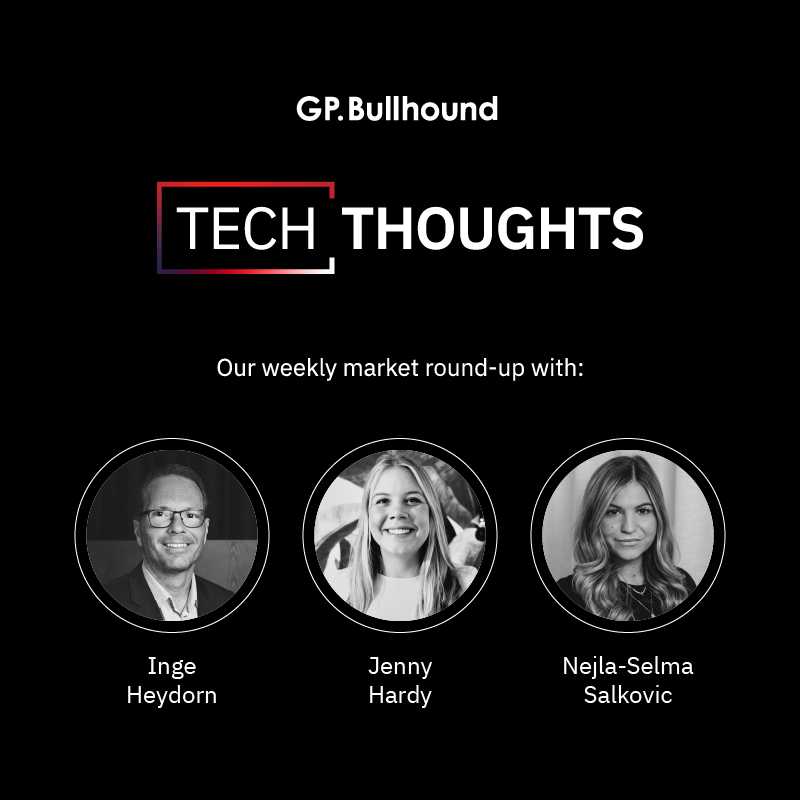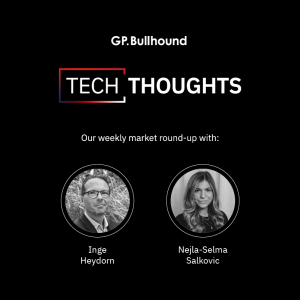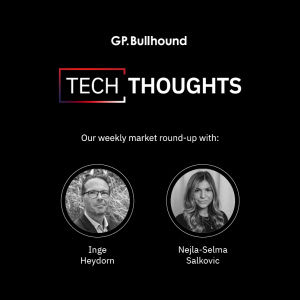Tech Thoughts Newsletter – 17 February 2023.

Market: The market continues to try to get its head around inflation expectations, interest rates (and where they will peak), and how badly the economy might be hurt.
Tech volatility continues to be high but for us, it creates opportunities: there are many areas of tech where fundamental demand is strong, and where the companies we own are seeing strong returns on investment.
Portfolio: We have not made any major changes in the portfolio during the week, though we slightly increased our positions in Apple and AMD.
One of the biggest debates we had as a team last year was whether the risk and the returns of the semiconductor industry are shifting. There were a few results this week – GlobalFoundries, ADI, Applied Materials – that made us think back to that debate.
The pandemic-related cancellations and shortages enabled TSMC (and other foundries and IDMs) to hold their customers to long-term purchase order agreements – and this is a phenomenon which we can see has continued and which is starting to become the industry standard.
It means that capex heavy players are being able to shift risk back to their customers. Previously boom and bust cycles would have all been weathered by chip manufacturers – they invest years ahead of demand and at one point or another, that demand turns and results in a glut of chip supply, and falling prices. Today we’re seeing manufacturers (like Global Foundries and TSMC) enter into long-term purchasing agreements with their customers to guarantee that some of that supply still gets sold, at agreed prices, regardless of demand.
It changes the dynamics of risk associated with capital intensity. Risk is being transferred away from the foundries and the semicap equipment players via non-cancellable orders, prepayments and under-utilisation charges. And that means that there’s a completely different risk, return and cyclicality profile associated with capex spend – which simply hasn’t been a feature of the industry at all through its history. We continue to think about this when we think about our long-term exposure in semis.
Onto results:
Network infrastructure strong alongside continued cloud build outs and new AI networks
- Cisco (owned) beat the quarter and raised guidance for the full year again – this time quite significantly – from 4.5-6.5% growth to 9-10.5% (July year-end). The CEO was very robust in stating that tech budgets are growing and they are clearly benefitting from strong demand in the sector (as we saw with Arista too – below).
- They think they will end the year with a backlog which is double the normal level, and it sounds like they can still deliver the historic 4-6% growth range in 2024, even after the outsized growth this year.
- It’s fair to say elsewhere in the supply chain we’ve seen a bit of a pause in datacentre demand as we’ve been through product upgrades with AMD Genoa and Intel Sapphire but this set of results supports the idea that that is all it is – a pause.
- Structurally, demand around cloud, changing traffic patterns of multi cloud, and hybrid work is all increasing. And importantly you have continued network/infrastructure redesigns to optimise the performance/power equation – as performance requirements everywhere continue to increase.
- CEOs across the board received questions this week on how ChatGPT impacts their business – for Cisco, it means increased network performance – they say 3x to 4x what they have historically needed – and that all means sustained demand for their products over time.
- Arista Networks (not owned) also beat and raised guidance on the back of strong hyper-scaler demand (their biggest customers are Microsoft and Meta and collectively their “cloud titans” grew triple digit yr/yr).
- Again, there are a lot of questions around what AI means for networking infrastructure. The simplistic view is that more compute requires more network bandwidth and switching intensity and again more demand for their products – they stated GPU clusters used to run AI chats need about 3x more bandwidth than a traditional compute network today
- Elsewhere in the cloud battle, Uber (not owned) has decided to move its IT platform from its own data centers to Google Cloud and Oracle. The deal is over 7 years but will be a gradual move. This is a good win for Google Cloud but especially for Oracle trying to position itself as a strong #4 in the market. Again – speaks more broadly to the structural growth in public cloud – even for a business at the scale of Uber, it doesn’t make sense for them to own and operate their own datacentres – there’s still a lot of the enterprise market that will switch to public cloud infra. That all speaks to the cloud battle and related investment continuing for Google, Micosoft, Amazon and Oracle.
Our conclusion: We like Network infrastructure as a way to play AI and increasing bandwidth requirements and increasing workloads. The visibility of Cisco’s business has also increased materially with a strong backlog and increased recurring revenues.
Semis strong and shifting industry risks
- Analog Devices (not owned) surprised positively, growing slightly faster than expected in the quarter but also guiding for an equally strong performance in the coming quarter.
- ADI is focused on B2B (89% of sales – really everything except for consumer) which was up 25% yr/yr and up 2% qtr/qtr in what is usually a down quarter. All B2B markets were up, Industrial and Automotive outperforming. They particularly highlighted the increasing semi content per unit of industrial capex – more efficient manufacturing requires more semi content – more automation, higher connectivity and greater energy efficiency which ADI feeds into. Semi content increases is something we’ve spoken a lot about for auto but as this shows it’s happening much more broadly.
- Consumer was weak as expected – down 5% yr/yr and 14% qtr/qtr – and that remains a market we’re cautious around.
- So ADI follows the pattern we have seen across the industry over the last 5-6 months with a major slowdown in consumer and with strong performance in automotive and core industrial.
- GlobalFoundries (not owned) reported a very good set of results and guide – ahead of expectations.
- The top line growth of 14% yr/yr was driven by mix and ASP which increased 20% yr/yr. Weakness in consumer and smartphone where we know we’re still in the midst of a quite stark inventory correction was offset by strength in Industrial IoT, auto and datacentre.
- They effectively upgraded their soft guidance around total auto revenue – rather than exiting 2023 at a $1bn run rate they will now make $1bn in auto revenue in the year – again speaking to the ongoing strength in that market.
- As we noted above, the business model and risk for the foundry industry is changing with customers now signing up long-term capacity contracts (LTAs) in order to guarantee semi capacity.
- GlobalFoundries increased the number of LTAs to 40 from 38 during the quarter with a total value of $27.5bn. On top of that has the shortage of semiconductors has lead to customers being more open for committed prepayments ($5bn) and capacity reservation fees.
- That reduces the volatility and increases the visibility for the foundries like GlobalFoundries and enables them to invest more systematically and have a better long-term plan for their business.
- The company did state that the demand uncertainty and the inventory correction has in some cases lead to negotiations with customers in order to manage short term adjustments in volume but there’s a commitment to still keeping the preserved intended economics and long-term value of the contracts – and for both parties to have balance sheets committed – as we said above, that’s very different from the old world!
Our conclusion: This is a clear positive for the semiconductor industry and reduces the volatility in the market. It clearly moves some risk from the foundries to its clients.
Semicap equipment – strong fundamentals continue
- Applied Materials (owned) beat the quarter ($6.74bn vs cons $6.66bn) and guided ahead ($6.4bn vs cons $6.3bn).
- By sector, they expect DRAM to pick up ahead of NAND (slightly better commentary than we might have expected on DRAM recovering towards the end of the year where to us that market still looks quite weak with higher inventories across the board – maybe AI is going to change the DRAM market dynamics quite rapidly?!).
- They expect leading edge foundry spending down slightly but comments on the long-term strength – in part driven by subsidies.
- The short-term isn’t unexpected – we know the capacity utilisation at players like TSMC and Intel is clearly lower, and there is clearly some scaling back of capacity additions – and we know a bulk of budget this year is going to the continued EUV (ASML) deployment. But there is still an emphasis that the short-term inventory situation in consumer isn’t impacting their customers’ long-term technology commitments.
- The real bright spot is orders accelerating in their ICAPS (IoT, Comms, Auto, Power and Sensors – effectively trailing edge) business which speaks to continued structural shortage we’ve spoken about and the increased investment plans coming from the long tail of spenders – mainly IDMs like TXN/STM/IFX as well as (we think) continued investment from China.
- Our view is that it makes a lot of sense for China to try to build up a very strategic position in trailing edge semis (where they already have ~30% share). The reality is that as ADI is showing there is a structural supply shortage in trailing edge globally; these trailing edge semis are critical (in autos, industrial) – that was clearly borne out by the shortage during the pandemic; and it is only really TSMC who have meaningful supply outside of China (Global Foundries is still relatively small in terms of capacity).
- Commentary elsewhere for TSMC/ASML – 3nm demand is very strong and they expect it to be a big investment for customers.
- Also some commentary around tech sovereignty which we continue to see as a big driver for the sector – adding “a few billion dollars per year in additional investment”. All helpful.
Our conclusion: Semicap is the critical enabler of the semis industries – it benefits from the structural growth we’ve spoken about, and from the shifting risk that’s giving its customers (TSMC, GF, IDMs) increased visibility. We continue to overweight the semicap equipment space in the portfolio.
Handset market in China showing signs of life…
- The Chinese smartphone market has been a significant headwind last year and this year. And still China consumer remains a big uncertainty for the semis industry.
- Counterpoint released a report stating that the beginning of 2023 has started off strongly for mobile handsets. The company states that four out of five weeks volumes in China have been above 6m and averaged 6.7m roughly inline with volumes seen in the beginning of 2022 after which volumes began to fall quite significantly – that would mean a significant stabilisation vs. the continued down trajectory.
Our conclusion; This is positive news although one datapoint and a limited time period. So it’s still really too early to call an improvement in the market for handsets in China and we remain cautious more around consumer exposed semis where visibility remains low.
Consumer still mixed
- Shopify beat but guided below expectations – now expecting Q1 growth in the “High teens” vs expectations of 20%. They commented that consumer spending remains under pressure in a higher inflationary environment and it’s not hard to imagine this continuing through the year, globally (China – as above, remains uncertain with regards to the recovery of the consumer)
- Airbnb (small position) reported in line results but guided ahead, as the recovery in travel (the one bright spot of consumer spend, still) continued. While the company doesn’t operate in China, it did see the ending of Zero Covid help the South East Asia region.
Our conclusion – we continue to limit our exposure to the end consumer spending and feel much more comfortable with other areas of spend related to cost savings (software) and efficiency gains (like cloud, and like the industrial automation ADI spoke about).
AI arms race fall out – memory to benefit?
- Back to the AI arms race, the Korean press reported Nvidia, Samsung and SK Hynix are all seeing rush orders for high bandwidth memory (HBM) related to ChatGPT and other AI chatbots that require faster processing speeds.
Our conclusion: we don’t own memory players – for us it’s a commoditised market reliant on the discipline of individual players which is very hard to predict. There’s no doubt though that DRAM may see a better picture with AI related demand – and for us that will be a benefit we see back through the semicap equipment market (as commented by AMAT) where players have made cuts to capacity.
Software seeing decelerating growth…
- Palantir (not owned) growth is coming down and faster than expected. The company exited the year at 18% growth, having started at 34%, and as we’ve seen elsewhere in the sector, without growth the focus was on better expected profitability.
- Datadog (not owned) reported better than expected 4Q sales but a disappointing outlook with growth expected to come down in 1Q, and FY23 expected to slow further with a continuation of cloud cost optimisation – like we’re seeing with the hyperscalers.
Our conclusion: Growth is decelerating in the software space – and customers are clearly reacting to a weaker macro environment – whether that’s smaller spend projects for Palantir or fewer workloads for Datadog. We continue to think software is an area of structural growth but it’s important that it has a meaningful ROI for customers, and where it does, we think spending around cost saving and efficiency projects will hold up well, but we certainly think that the time of easy sign offs for new software implementations and projects is behind us.
For weekly insights on the latest market updates, please subscribe to our Tech Thoughts podcast.
For more information about the latest trends and forecasts, please visit our official Tech Thoughts page.
We provide investors with access to category leading technology companies, globally. Our assets under management have a total value of more than €1bn, and our limited partners include institutions, family offices and entrepreneurs. Learn more about our funds here.
Enquiries
For enquiries, please contact:
Inge Heydorn, Partner, at inge.heydorn@gpbullhound.com
Jenny Hardy, Portfolio Manager, at jenny.hardy@gpbullhound.com
Nejla-Selma Salkovic, Analyst, at nejla-selma.salkovic@gpbullhound.com
About GP Bullhound
GP Bullhound is a leading technology advisory and investment firm, providing transaction advice and capital to the world’s best entrepreneurs and founders. Founded in 1999 in London and Menlo Park, the firm today has 13 offices spanning Europe, the US and Asia. For more information, please visit www.gpbullhound.com.

